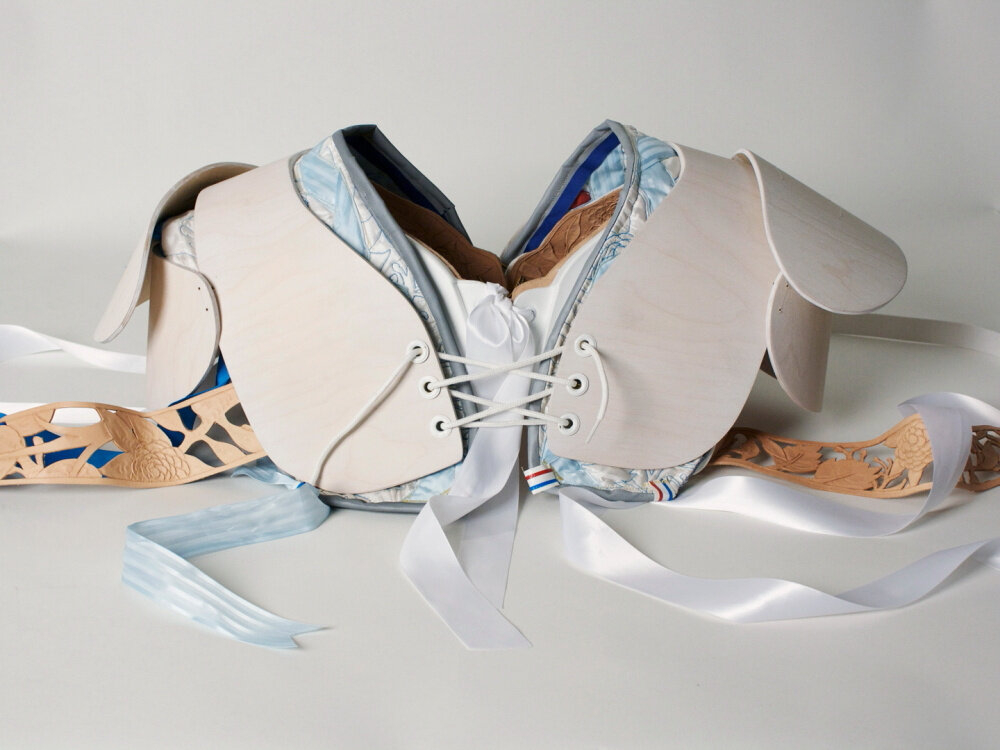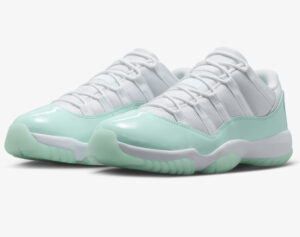
Betsy Odom’s 2009 sculpture, “Bulldog 30 (Shoulder Pads),” is a powerful exploration of gender, sports culture, and the intricate relationship between function and form. Odom, known for her sculptural works that challenge traditional gender roles and societal expectations, employs materials such as molded plywood, tooled leather, fabric, foam, and ribbon to create an artwork that blurs the boundaries between sports equipment and aesthetic objecthood. Measuring 10 x 12 x 30 inches, the sculpture is a striking representation of Odom’s ability to transform everyday objects into poignant social commentary.
The Artist: Betsy Odom
Betsy Odom is a contemporary artist whose work focuses on issues of gender identity, cultural expectations, and the intersection of craftsmanship and contemporary art. With a background in sculpture and woodworking, Odom often repurposes materials associated with masculinity and femininity, creating pieces that subvert traditional interpretations of gender-coded objects. Her work is deeply rooted in craft traditions, with a focus on meticulous detailing and the exploration of materials traditionally linked to both industrial production and domestic handcraft.
Odom has exhibited widely across the United States, with her work appearing in galleries and museums dedicated to exploring gender and social constructs. She draws inspiration from a variety of sources, including sports, fashion, and subcultures, which inform her unique aesthetic and conceptual approach.
“Bulldog 30 (Shoulder Pads)” – Concept and Context
“Bulldog 30 (Shoulder Pads)” is part of Odom’s larger exploration of sports culture and its inherent associations with masculinity and power. Shoulder pads, commonly associated with American football, are symbols of strength, aggression, and protection. In Odom’s interpretation, however, they are reimagined through the lens of craft and ornamentation, transforming them from purely functional objects into highly aestheticized artifacts.
The use of materials such as tooled leather and ribbon adds layers of meaning to the sculpture, challenging the viewer’s expectations and highlighting the tension between toughness and delicacy. The intricately worked surfaces of the shoulder pads resemble decorative elements found in traditional crafts, such as western saddle-making or leather tooling, which are often coded as feminine in their decorative flourish yet masculine in their function.
Materiality and Craftsmanship
One of the most compelling aspects of Odom’s work is her attention to materiality. In “Bulldog 30 (Shoulder Pads),” the careful combination of rigid plywood and soft fabric elements reflects a dichotomy between the masculine and the feminine. The meticulous handcrafting of the piece speaks to traditional forms of labor often undervalued in fine art contexts, such as leatherworking and sewing, which historically have been associated with domestic crafts.
By choosing to work with these materials, Odom reclaims the labor and craftsmanship associated with sportswear and protective gear, emphasizing the artistry that underpins even the most utilitarian objects. The juxtaposition of these materials also calls into question the very notion of protection—while shoulder pads serve to shield the wearer from impact, the use of delicate decorative elements challenges their functional intent, instead positioning them as symbols of cultural and aesthetic expression.
Themes Explored in “Bulldog 30 (Shoulder Pads)”
Odom’s sculpture touches on a variety of themes that resonate with contemporary discussions around gender, identity, and the aesthetics of athleticism. Some of the most prominent themes include:
Gender and Sports Culture
Sports culture has long been associated with hypermasculinity, often emphasizing traits such as strength, aggression, and competitiveness. Odom’s shoulder pads, however, challenge these associations by incorporating elements of beauty, craftsmanship, and ornamentation—qualities traditionally linked to femininity. In doing so, she critiques the rigid gender norms embedded in sports and invites a rethinking of how sports gear can function as an extension of identity beyond gender binaries.
The Intersection of Utility and Ornamentation
By transforming a functional piece of athletic equipment into an art object, Odom blurs the line between utility and decoration. The exaggerated decorative elements, such as intricate stitching and embossed patterns, suggest a reconsideration of what constitutes practical design versus aesthetic embellishment. In this way, the piece raises questions about how objects gain cultural meaning and how design choices can reflect deeper societal values.
Craft as a Form of Resistance
In a world increasingly dominated by mass production and uniformity, Odom’s dedication to handcrafting and detailed embellishment serves as a form of resistance. Her work challenges the impersonal nature of mass-produced athletic equipment by reintroducing individuality and artistic intervention. This subversion of industrial aesthetics positions craft as a powerful medium for self-expression and social critique.
The Cultural Significance of Sportswear
Athletic gear, such as shoulder pads, transcends its functional purpose and becomes a symbol of cultural identity and aspiration. Odom’s piece reflects on how sportswear communicates messages about power, belonging, and performance—both on and off the field. By reimagining these objects within an artistic context, she encourages viewers to consider their broader societal implications.
Critical Reception and Exhibition History
“Bulldog 30 (Shoulder Pads)” has been well received in the contemporary art world, featuring in exhibitions that explore themes of gender and sports. It was included in “Hand-Eye Coordination: Sports and Art,” curated by Abraham Ritchie, which examined the intersection of athletics and visual culture. The sculpture was also showcased in the “MASCS: Masculinity Reimagined” exhibition at the Morlan Gallery, a show dedicated to redefining traditional notions of masculinity through art.
Critics and scholars have praised Odom’s work for its ability to engage with critical social issues while maintaining a sense of humor and playfulness. Her unique approach to sculpture—melding traditionally “masculine” objects with intricate craftsmanship—has been described as both subversive and celebratory, highlighting the complexity of gender identity in contemporary culture.
The Broader Implications of Odom’s Work
Betsy Odom’s sculptures, including “Bulldog 30 (Shoulder Pads),” contribute to ongoing conversations about gender, labor, and material culture. By reimagining everyday objects in unexpected ways, Odom challenges audiences to rethink their assumptions about identity and the objects that shape our lives. Her work resonates with a broad audience, from those interested in feminist and gender theory to individuals engaged in discussions about the evolving nature of sports and fashion.
Influence on Contemporary Art
Odom’s influence extends beyond sculpture into broader contemporary art practices that address gender and material culture. Her work aligns with that of artists such as Mickalene Thomas and Kehinde Wiley, who similarly incorporate decorative elements and historical references to challenge contemporary understandings of identity and representation. Odom’s approach to materials and craft positions her within a growing movement of artists who are reclaiming traditional techniques to subvert modern narratives.
Potential Future Directions
Looking ahead, Odom’s work continues to evolve, with potential explorations into new materials and interdisciplinary collaborations. As conversations around gender fluidity and representation in sports gain momentum, her sculptures remain highly relevant and serve as visual markers of cultural change. Future works may further investigate the intersection of athleticism, identity, and self-expression, offering new perspectives on these interconnected themes.
Betsy Odom’s 2009 sculpture, “Bulldog 30 (Shoulder Pads),” is a remarkable example of how contemporary art can challenge and expand our understanding of gender, identity, and the cultural significance of objects. Through her meticulous craftsmanship and thoughtful conceptual approach, Odom transforms an everyday piece of sports equipment into a compelling exploration of masculinity, femininity, and the aesthetics of function.
Whether viewed as a critique of traditional gender roles, an homage to craft traditions, or a celebration of individuality within sports culture, Odom’s work invites viewers to engage with it on multiple levels. As sports, fashion, and art continue to intersect in new and unexpected ways, pieces like “Bulldog 30 (Shoulder Pads)” serve as important cultural artifacts that reflect the shifting landscape of identity and representation in the modern world.
No comments yet.








